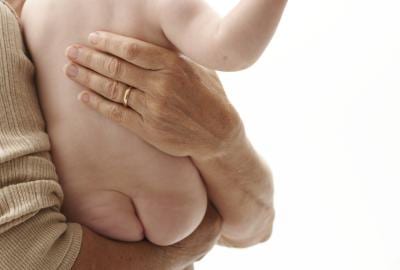A baby’s skin is usually silky soft — but it may also be bumpy, red, splotchy, or pimply. Babies, especially newborns, suffer from a number of common skin problems. While such conditions may be worrisome to new parents, most infant skin problems are temporary and won’t harm your baby, according to WebMD. In fact, most skin conditions, especially rashes, simply disappear with time.
Causes
Skin problems in babies have a wide variety of causes. Hormonal changes can cause them, as can blocked oil glands, especially in the scalp and face. Food sensitivities, including food allergies, can cause skin rashes in older babies. Heat can cause a bumpy rash to break out on a baby. Some late-term babies are born with dry skin. Fungi can cause ringworm. Viruses and bacterial illnesses are another common cause of skin problems in babies. In some cases, such as when newborns develop Erythema toxicum — a completely harmless that goes away on its own — the cause is unknown.
Types
Milia is a skin condition common in newborns, according to DrGreene.com. In fact, over half of all newborns develop this skin problem, which appears as tiny bumps on the face. Baby acne is also commonly seen in infants and looks just like adult acne. Cradle cap is a scalp conditions that presents as areas of crusty or oily patches. Hives are red, raised swollen areas on the skin. They usually appear on the face, trunk and belly and can be an allergic response to a skin irritant or something the baby ate. Eczema is a skin condition that is often inherited. It is a rash that can be bright red, bumpy and itchy. The exact cause of eczema is not known. Diaper rashes are bright red and sometimes bumpy. They are caused by irritated skin and severe diaper rashes can bleed.
Warning
A doctor should evaluate rashes or skin conditions that are accompanied by other symptoms such as a fever, vomiting or diarrhea. These symptoms can signify a viral or bacterial infection. Blisters that develop and fill with fluid can also signify an infection. Tiny, purple specks that appear anywhere on the skin and do not fade when you press on them are called petechiae; they can indicate that your baby has a serious infection. If you see such markings on your baby’s skin, get her to a doctor immediately.
Prevention/Solution
Rashes that come and go usually have an external cause. This could be an irritating detergent or a food allergy such as an allergy to berries. If you can track the cause of the rash, you might be able to prevent it. Usually, only skin problems caused by viruses or bacterial infections need treatment. Do not try to scrub your baby’s skin, especially if she has baby acne or milia. This will only irritate the problem, according to MayoClinic.com. Instead, wash your baby’s skin as normal with a mild soap and pat it dry gently. You should treat diaper rashes and heat rashes by exposing the area to air and by keeping the skin dry.
Considerations
Some skin problems might not be problems at all, but normal variations in your baby’s skin. Salmon patches and Mongolian spots are dark areas on the skin and some babies are born with them. Jaundice, a slight yellowing of the skin, is a condition that affects a little over half of all newborns. It is caused by bilirubin buildup in the blood and goes away within 1 to 2 weeks after birth, according to MayoClinic.com.





